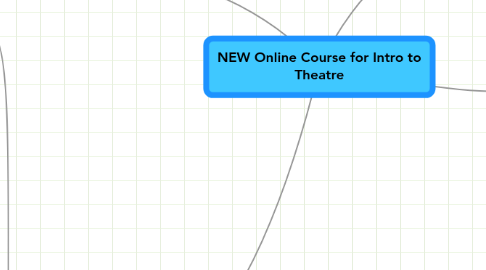
1. Course Learning Outcomes
1.1. At the conclusion of the course, students should be able to:
1.2. Describe the primary components required to create theatre and explain the necessity of each of those components
1.3. Discuss theatre's universality (across cultural and temporal boundaries) and explain the elements that contribute to theatre's universality
1.4. Discuss the roles and responsibilities of the various theatre artists who work collaboratively on a theatrical production (actors, playwrights, directors, designers)
1.5. Distinguish between genres of theatre (tragedy, drama, comedy, realistic vs. nonrealistic)
2. UNITS
2.1. The Building Blocks
2.1.1. Learning Objectives for this Unit
2.1.1.1. At the conclusion of this Unit, students should:
2.1.1.2. Identify and discuss the components that contribute to theatre's universality
2.1.1.3. Discuss how theatre's liveness makes it a unique experience for both performers and audience, and how theatre differs from other performance media (film/tv)
2.1.1.4. Identify the critical components of theatre as outlined in Aristotle's The Poetics
2.1.1.5. Identify and explain the function of the parts of a plot structure diagram
2.1.1.6. Compare and contrast various commonly used theatre spaces
2.2. The Collaborative Artists
2.2.1. Learning Objectives for this Unit
2.2.1.1. At the conclusion of the Unit, students should be able to:
2.2.1.2. Describe the duties, parameters and collaborative techniques of the playwright
2.2.1.3. Describe the techniques, processes and duties of the actor
2.2.1.4. Describe the responsibilities and techniques of the director
2.2.1.5. Describe the techniques, goals, and materials of the scenic designer
2.2.1.6. Describe the techniques, goals, and materials of the costume designer
2.2.1.7. Describe the techniques, goals, and materials of the lighting designer
2.3. Genres and Styles
2.3.1. Learning Objectives for this Unit
2.3.1.1. At the conclusion of this Unit, students should be able to:
2.3.1.2. Identify a piece of theatre as classic or modern tragedy
2.3.1.2.1. Modern Tragedy
2.3.1.2.2. Classical Tragedy
2.3.1.3. Identify types of non-tragic serious drama
2.3.1.3.1. Other Dramatic Styles
2.3.1.4. Identify different comic techniques and styles
2.3.1.4.1. Comic Styles
2.3.1.5. Identify specialized types of theatre
2.3.1.5.1. Absurdism
2.3.1.5.2. Pattern
2.3.1.5.3. Musical
